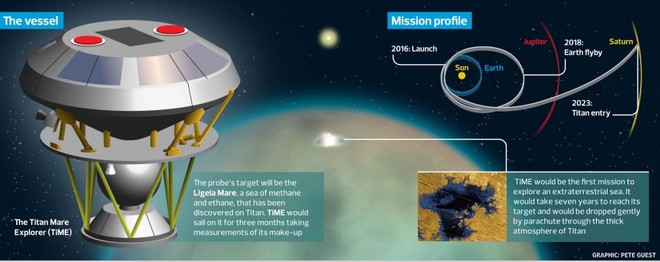Space engineers plan sailing on Titan, Jupiter's largest moon
by The Guardian/Sail-World Cruising on 16 May 2011

Ligeia Mare project - it doesn’t look much like a sailing boat SW
Sailing - the ability to move along impelled by the natural force of the wind - is figuring largely in space exploration as scientists search for ways of using the forces found in the universe.
Japan's sailing vessel Ikaros is on its way to Venus propelled by solar wind (photons), and now space engineers are planning their first extra-terrestrial yacht, destined to sail on the Ligeia Sea (Ligeia Mare), a sea of methane and ethane on the surface of Titan, Jupiter's largest moon.
The robot ship, which admittedly doesn't look much like a sailing boat, would sail around this sea for several months, exploring its coastline and measuring the winds and waves that sweep its surface. 'Waves on Titan's seas will be far larger, but much slower, than on earthly oceans, according to our calculations,' Professor John Zarnecki, of the Open University told The Guardian this week. 'That suggests Titan is the best spot in the solar system for surfing. The only trouble is that the temperature there is -180C (-290F). Either way you look at it, it is clear the place is pretty cool.'
The mission to Titan – the only moon in the solar system with a thick atmosphere, of nitrogen and methane – would be the first exploration of a sea beyond Earth and could provide evidence about the possible existence of complex organic chemicals, the precursors of life.
'Methane is a gas on Earth, but because Titan is so cold it acts as a liquid there,' added Zarnecki, who is working with US scientists on the construction of the Titan boat probe. 'It exists as a liquid, a gas and a solid, just like water on Earth, depending on conditions in a particular area. Methane also cycles between Titan's surface and its atmosphere, just as water does on Earth. It drives the weather there.'
Ultraviolet radiation from the Sun reacts with this methane, causing it to form complex hydrocarbons that slowly fall back to the surface. In short, it rains petrochemicals on Titan. Rivers of the stuff wash down valleys and form lakes and seas. Over the past seven years, these petrochemical seas have been mapped by US robot spaceship Cassini. In addition, Cassini deployed a smaller probe, called Huygens – built by the European Space Agency – which landed on Titan in 2005. Many of the instruments for that craft were built by Zarnecki and his Open University team. This experience led to a request for them to join the Titan Mare Explorer, or TiME, project that is being funded by Nasa and led by Ellen Stofan, a researcher with the science organisation Proxemy Research.
According to her plans, the TiME probe would be fired at Titan on a billion-mile journey across the solar system. Once it enters the moon's thick atmosphere the craft would parachute down towards the surface and then drop into the 300-mile-wide Ligeia Mare. It would then spend several months afloat on an oily sea taking measurements of waves, chemicals and other variables.
'The probe's main instrument will be a mass spectrometer, which will tell us exactly what the lake is made of. However, we also want to do things like depth-sounding,' said Stofan. The instruments would be powered by a small nuclear generator, because Titan is so distant from the Sun that solar panels cannot be used to provide power for detectors or transmitters.
Titan is also thought to have an ocean of water deep underground. Complex organic chemicals, created on its surface, could be seeping down through fissures so that primitive lifeforms could have evolved in relatively warm waters beneath the moon's surface. Hence scientists' interest in studying Titan.
The TiME probe was originally selected as one of 28 missions that Nasa was considering as future projects. Twenty-five of these candidate missions have now been rejected, and the Titan mission now has only two other competitors for the £300m funding that will be needed for its development and launch. The other two are a seismic monitoring station for Mars and a comet-hopping probe. Detailed plans for all three are now being worked out by scientists, and the winner will be chosen after a review in 2012. In the case of TiME, launch would be in 2016, with the ship arriving seven years later.
'When the proposal for the TiME mission went in, it had a one-in-28 chance of success,' said Zarnecki. 'Now Nasa have shortlisted it, it has a one-in-three chance – that's getting serious. I didn't think I had a chance of returning to Titan in my career. Now that's all changed.'
If you want to link to this article then please use this URL: www.sailworldcruising.com/83525